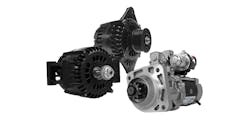Before I dive into this topic, it should be noted right at the outset that vehicle thefts in the U.S. are dropping. Preliminary statistics gathered by the Federal Bureau of Investigation point to a 7.2% reduction in vehicle thefts last year over 2009.
And should the preliminary numbers hold when the FBI produces its final statistics later this year, 2010 will post the fewest vehicle thefts since 1967, according to the National Insurance Crime Bureau (NICB), which is a not-for-profit organization exclusively dedicated to preventing, detecting and defeating insurance fraud, vehicle theft, and cargo theft.
All that being said, however, a worrisome trend is developing for fleets that rely on light trucks, especially pickups: they are becoming far more popular targets for vehicle thieves.
Just take a look at the NICB’s recently released “Hot Wheels” list, which charts the top 10 most stolen vehicles on a yearly basis. In ranked order, the 10 most popular stolen vehicles for 2010 were:
1994 Honda Accord
1995 Honda Civic
1991 Toyota Camry
1999 Chevrolet Pickup (Full Size)
1997 Ford F150 Series pickup
2004 Dodge Ram pickup
2000 Dodge Caravan (minivan)
1994 Acura Integra
2002 Ford Explorer SUV
1999 Ford Taurus
Right there, ranked fourth, fifth, and sixth respectively, are pickup truck models in wide use among many fleets in the U.S. Again, though, with vehicle theft rates in decline, this doesn’t mean these pickups will suddenly start vanishing left and right off of every street corner.
But it does mean any and all owners of these trucks – from single-truck contractors on up to fleet operations with hundreds of these models hitting the road every day – need to be aware that they are being targeted more frequently by thieves.
[NICB also identifies the “hot spots” for vehicles thefts across the U.S. as well, to help vehicle owners and operators better gauge the risk to their equipment.]
NICB explains that certain models of older cars and trucks are popular with thieves because of the value of their parts; vehicles that, due to their age, are often not insured against theft, leading to a “double whammy” for owners.
On the flip side, though, newer, more expensive and insured vehicles are often stolen to be resold intact with counterfeit vehicle identification numbers or are shipped out of the country entirely. Yet new vehicles are being targeted less and less because of technology being built-in by automakers making them harder to steal.
For example, of the nearly 52,000 Honda Accords stolen in 2010, over 44,000 were models made in the 1990s, compared with fewer than 5,700 that were produced since the year 2000.
It’s also worthy to note that nationally—and for the first time since 2002—thieves are now preferring domestic makes over foreign brands. Ford took three spots, Dodge two and Chevrolet held one while the remaining four were held by Honda, Toyota and Acura. However, the top three positions continue to be held by Honda and Toyota models, a trend that has been consistent since 2000.
[Here’s a little deeper insight into why older Honda and Toyota car models are still the most popular vehicles to steal … and believe it or not street racing has a lot to do with it.]
To combat vehicle theft, NICB suggests what it calls taking a “layered approach” by using very basic (and cheap) tactics to make cars and light trucks less attractive to thieves:
• Common Sense: Lock your car and take your keys. It's simple enough, but many thefts occur because owners make it easy for thieves to steal their cars.
• Warning Device: Having and using a visible or audible warning device is another item that can ensure that your car remains where you left it.
• Immobilizing Device: Generally speaking, if your vehicle can't be started, it can't be stolen. Such things as "kill" switches, fuel cut-offs and smart keys are among the devices that are extremely effective in immobilizing stolen vehicles.
• Tracking Devices: A tracking device emits a signal to the police or to a monitoring station when the vehicle is stolen. Tracking devices are very effective in helping authorities recover stolen vehicles. Some systems employ telematics, combining GPS and wireless technologies to allow for remote monitoring of a vehicle. If the vehicle is moved, the system will alert the owner and the vehicle can be tracked via computer.
At the end of the day, it just means theft prevention is just one more thing fleet managers must keep at the back of their mind as they go about their day. It’s an extra hassle, for sure, but as its seems vehicle thieves are stalking more and more pickup models, it would be wise to spend some time thinking about it.



